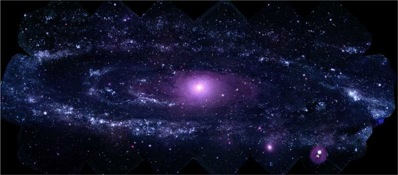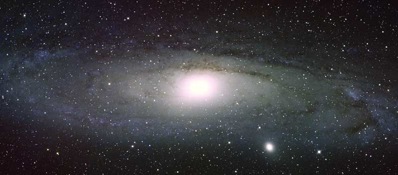


|

|
 |
|
Swift's portrait of Andromeda DR EMILY BALDWIN ASTRONOMY NOW Posted: September 17, 2009 Taking time out from its typical agenda of searching for distant cosmic explosions, NASA's Swift satellite has acquired the highest resolution view of the Andromeda galaxy in ultraviolet. The Andromeda galaxy, or M31, is the largest and closest spiral galaxy to our own, residing at a distance of 2.5 million light years away. It spans 220,000 light years across and between 25 May and 26 July 2008 Swift's Ultraviolet/Optical Telescope (UVOT) acquired 330 images of our galactic neighbour at wavelengths of 192.8, 224.6, and 260 nanometers, representing a total exposure time of 24 hours.  Click to see the image in its full glory. This mosaic of M31 merges 330 individual images taken by the Ultraviolet/Optical Telescope aboard NASA's Swift spacecraft. The image shows a region 200,000 light-years wide and 100,000 light-years high. Image: NASA/Swift/Stefan Immler (GSFC) and Erin Grand (UMCP).
Click to see the image in its full glory. This mosaic of M31 merges 330 individual images taken by the Ultraviolet/Optical Telescope aboard NASA's Swift spacecraft. The image shows a region 200,000 light-years wide and 100,000 light-years high. Image: NASA/Swift/Stefan Immler (GSFC) and Erin Grand (UMCP).
“Swift reveals about 20,000 ultraviolet sources in M31, especially hot, young stars and dense star clusters,” says Stefan Immler, a research scientist on the Swift team at NASA’s Goddard Space Flight Center. “Of particular importance is that we have covered the galaxy in three ultraviolet filters. That will let us study M31’s star-formation processes in much greater detail than previously possible.” The survey resulted in 85 gigabytes worth of images that were assembled by summer intern student Erin Grand. “After ten weeks of processing that immense amount of data, I’m extremely proud of this new view of M31,” she says. The new mosaic reveals the striking difference between the galaxy's central bulge and its spiral arms. “The bulge is smoother and redder because it’s full of older and cooler stars,” Immler explains. “Very few new stars form here because most of the materials needed to make them have been depleted.”  This optical view from a ground-based telescope shows the Andromeda Galaxy in a more familiar light. This image encompasses the same area as the Swift mosaic. Image: Bill Schoening, Vanessa Harvey/REU program/NOAO/AURA/NSF.
This optical view from a ground-based telescope shows the Andromeda Galaxy in a more familiar light. This image encompasses the same area as the Swift mosaic. Image: Bill Schoening, Vanessa Harvey/REU program/NOAO/AURA/NSF.
A reflection of our own Galaxy, M31's disc and spiral arms are abundant with pockets of gaseous and dusty material needed to spawn new generations of stars. Star clusters are particularly plentiful in an enormous ring about 150,000 light years across. This so-called 'ring of fire' is thought to result from tides raised by the many small satellite galaxies in orbit around M31, which help boost the interactions within gas clouds that triggers new star formation. “Swift is surveying nearby galaxies like M31 so astronomers can better understand star formation conditions and relate them to conditions in the distant galaxies where we see gamma-ray bursts occurring,” says Neil Gehrels, the mission’s principal investigator at NASA Goddard. Swift has already detected over 400 gamma-ray bursts since its launch in 2005, explosions that are thought to be associated with the birth of black holes. |
|
|
|
|